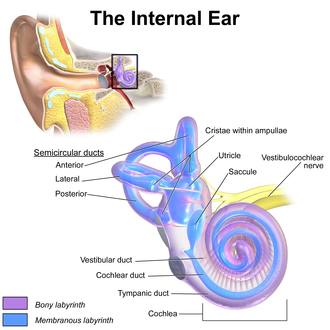
Back كييس (تشريح) Arabic Sakulus BS Sàcul Catalan Kulovitý váček Czech Sáculo Spanish Sakulu Basque Sacculus dan utriculus ID Sacculo Italian 둥근주머니 Korean Woreczek Polish
| Saccule | |
|---|---|
 Inner ear, showing saccule near center. | |
 illustration of otolith organs showing detail of utricle, otoconia, endolymph, cupula, macula of saccule, hair cell filaments, and saccular nerve | |
| Details | |
| Part of | Inner ear |
| System | Balance |
| Identifiers | |
| Latin | sacculus |
| TA98 | A15.3.03.065 |
| TA2 | 7001 |
| FMA | 61116 |
| Anatomical terminology | |
The saccule (Latin: sacculus) is a bed of sensory cells in the inner ear that detects linear acceleration and head tilting in the vertical plane, and converts these vibrations into electrical impulses to be interpreted by the brain. When the head moves vertically, the sensory cells of the saccule are moved due to a combination of inertia and gravity. In response, the neurons connected to the saccule transmit electrical impulses that represent this movement to the brain. These impulses travel along the vestibular portion of the eighth cranial nerve to the vestibular nuclei in the brainstem.
The vestibular system is important for balance, or equilibrium. It includes the saccule, utricle, and the three semicircular canals. The vestibule is the name of the fluid-filled, membranous duct that contains these organs of balance and is in turn encased in the temporal bone of the skull as a part of the inner ear.